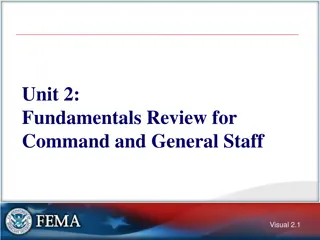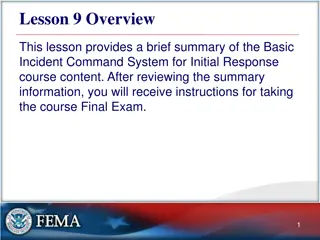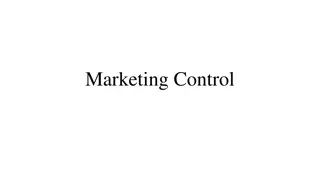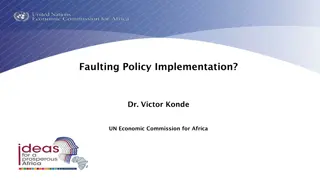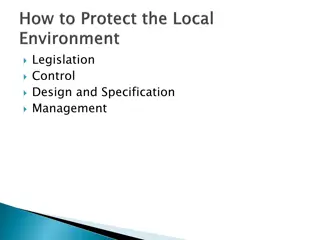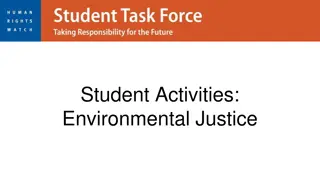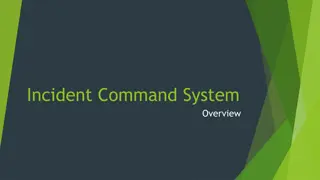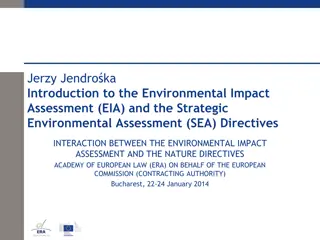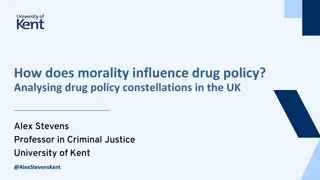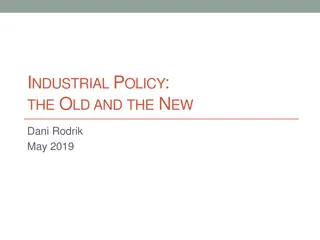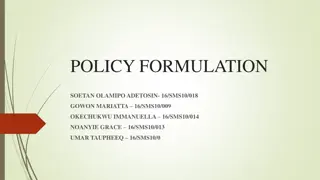Command-and-Control Strategies in Environmental Policy
This chapter discusses the concept of command-and-control strategies in environmental policy, focusing on the use of standards to regulate behavior and improve environmental quality. It explores the implementation of emission standards, compliance costs, and the popularity of standards for their simplicity and ethical alignment with anti-pollution sentiments.
Download Presentation

Please find below an Image/Link to download the presentation.
The content on the website is provided AS IS for your information and personal use only. It may not be sold, licensed, or shared on other websites without obtaining consent from the author.If you encounter any issues during the download, it is possible that the publisher has removed the file from their server.
You are allowed to download the files provided on this website for personal or commercial use, subject to the condition that they are used lawfully. All files are the property of their respective owners.
The content on the website is provided AS IS for your information and personal use only. It may not be sold, licensed, or shared on other websites without obtaining consent from the author.
E N D
Presentation Transcript
Command-and-Control Strategies: The Case of Standards Chapter 11
Command and Control A command-and-control (CAC) approach mandates the behavior in law, then uses whatever enforcement machinery courts, police, fines, and so on are necessary to get people to obey the law. In the case of environmental policy, the command-and-control approach consists of relying on standards of various types to bring about improvements in environmental quality. 2
Standards An emission (performance) standard is a maximum rate of emissions that is legally allowed. If you want people not to do something, simply pass a law that makes it illegal, then send out the authorities to enforce the law. 3
Illustrating Standards Figure 11-1 shows marginal abatement costs and marginal damages related to the rate at which some production residual is emitted. Suppose that initially the actual level of effluent is at e1, a rate substantially above the efficient rate of e*. To achieve e* the authorities set an emission standard at that level; e* becomes a mandated upper limit for the emissions of this firm. 4
Compliance Costs Assuming the firm reduces emissions in accordance with the standard, it would be incurring an amount equivalent to area a per year in total abatement costs. These total abatement costs are the compliance costs of meeting the standard. 6
Popularity of Standards Standards are popular for a number of reasons. They appear to be simple and direct. They apparently set clearly specified targets. Standards also appear to be congenial to our ethical sense that pollution is bad and ought to be declared illegal. The legal system is geared to operate by defining and stopping illegal behavior, and the standards approach conforms to this mindset. 7
Types of Standards There are three main types of environmental standards: ambient, emission, and technology. Ambient Standards Ambient environmental quality refers to the qualitative dimensions of the surrounding environment. Ambient standards are normally expressed in terms of average concentration levels over some period of time. 8
Emission Standards Emission standards are never-exceed levels applied directly to the quantities of emissions coming from pollution sources. Emission (or effluent) standards are normally expressed in terms of quantity of material per some unit of time; for example, grams per minute or tons per week. Standards may set upper limits on the quantity of flow per minute the average flow over some time period. 9
Link Between Emissions and Ambient Quality The link between emissions and ambient quality also can be vitally affected by human decisions. A classic case is automobiles. As part of the mobile-source air-pollution program, emission standards have been set for new cars in terms of emissions per mile of operation. No effective way of controlling either the number of cars on the roads or the total number of miles each is driven, so total pollution and, thus, ambient air quality, is not directly controlled. 10
Variety of Emission Standards 1) Emission rate (e.g., pounds per hour). 2) Emission concentration (e.g., parts per million of biochemical oxygen demand, or BOD, in wastewater). 3) Total quantity of residuals (rate of discharge times concentration times duration). 4) Residuals produced per unit of output (e.g., SO2 emissions per kilowatt-hour of electricity produced). 5) Residuals content per unit of input (e.g., SO2 emissions per ton of coal burned in power generation). 6) Percentage removal of pollutant (e.g., 60 percent removal of waste material before discharge). 11
Performance Standards In the language of regulation, emission standards are a type of performance standard because they refer to end results that are meant to be achieved by the polluters who are regulated. 12
Technology Standards There are numerous standards that don't actually specify some end result, but rather the technologies, techniques, or practices that potential polluters must adopt. The requirement that cars be equipped with catalytic converters, or seat belts, is a technology standard. If all electric utilities were required to install stack-gas scrubbers to reduce SO2 emissions, these would be in effect technology standards because a particular type of technology is being specified by central authorities. 13
Emission vs. Technology Standards The basic point of differentiation is that a performance standard, such as an emission standard, sets a constraint on some performance criterion and then allows people to choose the best means of achieving it. A technology standard actually dictates certain decisions and techniques to be used, such as particular equipment or operating practices to be used by polluters. 14
The Economics of Standards It would seem to be a simple and straightforward thing to achieve better environmental quality by applying standards of various types. Standards appear to give regulators a degree of positive control to get pollution reduced, but standards turn out to be more complicated than they first appear. 16
Any Hope of Finding e*? Standards are established through a political/administrative process that may account for all kinds of considerations. The most fundamental question is whether, in setting standards, authorities should take into account only damages or both damages and abatement costs. 17
Zero-Risk is Not Efficient A principle used in some environmental laws has been to set the standard at a "zero-risk" level a level that would protect everyone, no matter how sensitive, from damage. This would imply setting emission standards at the threshold level, labeled etin Figure 11- 1. 18
Balancing with Abatement Costs The standard might instead be set at a level that accepts a "reasonably small" amount of damages, for example, e0, the point where the marginal damage function begins to increase very rapidly. Again, this would be setting the standard without regard to abatement costs. A different logic might suggest that in setting the standard, damages ought to be balanced with abatement costs. 20
Uniformity of Standards A very practical problem in standard setting is whether it should be applied uniformly to all situations or varied according to circumstances. This can be illustrated by using the problem of the spatial uniformity of standards. The ambient air-quality standards in the United States, for example, are essentially national. The problem with this is that regions may differ greatly in terms of the factors affecting damage and abatement cost relationships. 21
Seeking Efficiency? A single, uniform standard cannot be efficient simultaneously in the two regions. If it is set at eUit will be overly stringent for the rural area, and if it is set at erit will not be tight enough for the urban region. The only way to avoid this would be to set different standards in the two areas. Policy trade-offs: The more a policy is tailored so that it applies to different and heterogeneous situations, the more efficient it will be in terms of its impacts, but also the more costly it will be to set and enforce them. 23
Standards and the Equimarginal Principle We need to remember that the efficient level itself is defined by the minimum marginal abatement cost function. This means that, where there are multiple emissions sources producing the same effluent, the equimarginal principle must hold. 24
Marginalism In order to get the greatest reductions in total emissions for a given total abatement cost, the different sources of emissions must have the same marginal abatement costs. This means that different sources of a pollutant would normally be controlled to different degrees, depending on the shape of the marginal abatement cost curve at each source. 25
Problem of Standards A major problem with standards is that there is almost always an overwhelming tendency for authorities to apply the same standards to all sources. It makes their regulatory lives much simpler, and it gives the impression of being fair to everyone because all are apparently being treated alike. But identical standards will be cost-effective only in the unlikely event that all polluters have the same marginal abatement costs. 27
Standards and Incentives in the Short Run Standards are likely to be neither efficient nor cost effective. A basic problem is that standards are all-or- nothing either they are being met or they are not. If they are being met, there is no incentive to do better than the standard, even though the costs of further emission reductions may be quite modest. By the same token, the incentives are to meet the standards, even though the last few units of emission reduction may be much more costly than the damages reduced. 28
Perverse Incentives Standards in practice tend to take decision flexibility away from polluters. This is certainly the case with technology standards, which dictate the procedures that polluters must follow, even though other procedures may be available to achieve the goal at lower cost. Polluters will avoid other techniques in order to protect themselves against charges of non-compliance, even if these other approaches show considerable promise. 29
Standards and Incentives in the Long Run Technology Standards provide no incentive to find cheaper ways of reducing emissions. Emission (performance) Standards provide strong incentives to find cheaper ways of reducing emissions. See Figure 11-4. 30
Political-Economic Aspects of Standards Standards are often set under political give- and-take. Technology forcing is to set standards that are costly with today's technology in the hope that it will motivate the pollution-control industry to invent ways of meeting the standard at reasonable cost. But stricter standards also create another incentive: the incentive for polluters to seek relief from public authorities by delaying the date when they become applicable. 32
Pollution Control Industry The incentives of pollution-control policy for technological change depend on policies. Technology standards substantially reduce incentives for entrepreneurs in the pollution- control industry to develop new ideas. Representatives of the pollution-control industry favor stricter emission (performance) standards, as their fortunes are tied directly to the degree of stringency in the emissions standards set by public authorities. 33
The Economics of Enforcement The typical pollution-control law calls for emissions reduction from current levels or the adoption of specified pollution-control technologies. Ex ante, penalties will be sufficient to produce complete compliance, but this is in fact never the case. Pollution-control laws, like any others, require enforcement. 34
Enforcing Emission Standards Consider Figure 11.5. Crossing the MAC function is a marginal penalty function. MPC represents the expected penalties that firms can be expected to face for violating an emission standard. Penalties arise when firms are detected to be exceeding their emission standard. 35
Avoiding Penalty? Suppose a standard is set at e*. MPC is zero below e*, the firm is only penalized for emissions in excess of the standard, and the shape of the MPC curve shows how penalties would increase as the size of the violation increases. If current emissions are at e0, the firm will clearly reduce them because marginal abatement costs at this point are well below the marginal penalty costs currently in effect. 37
Noncompliance Firm stops reducing emissions at e1. Abatement costs are higher than penalties. Unless something changes, the firm's emissions will end up at e1, and the amount of noncompliance will be e* - e1. In many cases, fines have been set too low lower than the abatement costs required to meet the standards. 38
Enforcing Technology Standards Initial compliance means a polluter installs the appropriate equipment. Inspectors visit the site, check to see that the equipment is installed, and make sure it will operate in accordance with the conditions of the standard. The administering agency can then give the firm the necessary operating permit. Does not ensure that the equipment will continue to be operated in the future in accordance with the terms of the permit. 39
Monitoring Compliance Device may deteriorate through normal use, it may not be maintained properly, future operating personnel may not be properly trained, and so on. Without some amount of monitoring, there is no assurance that the source will continue to be in compliance. 40
Trade-Offs Standards often are set by national authorities; enforcement is usually done by local authorities. There can be a great deal of informal give-and- take between the authorities and local plant managers, with participation by local environmental groups as well. One of the advantages (some might say disadvantages) of policies using standards is that they permit flexibility in enforcement. 41
Summary Standards (especially technology standards) are not cost-effective. Pollution control can be cost-effective only when marginal abatement costs are equalized across sources. In practice, differences among sources in their marginal abatement costs may be recognized informally by local administrators in applying a uniform national standard. 42




